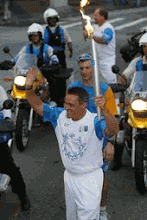
For a few weeks every four years, Olympic-level whitewater slalom racing enjoys the bright lights and world-wide attention that only the power of the Olympic stage can deliver. From the athletes to media to sponsors to mainstream sports fans alike, it’s a short window in which a niche sport like kayaking enjoys pure sunlight and then tries to sustain that energy for another Olympic cycle.
So, as the 2008 Olympic selection gets set to start in the coming weeks, I begin to wonder what are the pieces from this Olympic run that will fuel this sport for another few years following the Beijing Games? Of course the U.S. program has a few bona fide medal contenders and genuine people like Scotty Parsons, who set an impeccable standard of performance and character. But, while observing “seriously good” racer after racer nimbly blitzing their 11-foot carbon boats through the slalom course at the U.S. Open Whitewater Championships this past weekend, I couldn’t help to feel that the already wide gap between kayak racing and kayaking had just widened out some more.
 And then, something changed. First, Emily Jackson barrels down the course exuding happiness from ear to ear. A few minutes later, her father and my ’92 Olympic teammate, Eric, flexes his grin while making the tricky course look too easy. Finally, Dane, the youngest of the family, is happiest when changing the challenge of navigating whitewater and gates into a blissful learning on-they-fly pursuit. Together, these three are the heart and soul of kayaking’s infectious smile, the brand logo of the family’s world-class kayak company, Jackson Kayaks. The smiling symbol represents an attitude that has changed kayaking and redefined what fun is on the river. For a few minutes at one of the most intense slalom races of the spring, the three Jacksons have made me forget that whitewater slalom is an elite endeavor that is extremely hard in which to break in and belong. For a few minutes, the nervous anticipation of family and friends watching from the shore has turned into a simple and fun spectator experience.
And then, something changed. First, Emily Jackson barrels down the course exuding happiness from ear to ear. A few minutes later, her father and my ’92 Olympic teammate, Eric, flexes his grin while making the tricky course look too easy. Finally, Dane, the youngest of the family, is happiest when changing the challenge of navigating whitewater and gates into a blissful learning on-they-fly pursuit. Together, these three are the heart and soul of kayaking’s infectious smile, the brand logo of the family’s world-class kayak company, Jackson Kayaks. The smiling symbol represents an attitude that has changed kayaking and redefined what fun is on the river. For a few minutes at one of the most intense slalom races of the spring, the three Jacksons have made me forget that whitewater slalom is an elite endeavor that is extremely hard in which to break in and belong. For a few minutes, the nervous anticipation of family and friends watching from the shore has turned into a simple and fun spectator experience.The one brand that has profoundly impacted kayaking more than any other in the past decade is the one brand that whitewater slalom needs more than ever. The Jacksons acutely understand what their paddling stands for and they share it with others in connective ways that go far beyond what kayaking people thought was possible in this sport. Quite simply, nobody sells “smiles on the river” better than the Jacksons.
More than any other segment of kayaking, whitewater slalom racing could really use a few smiles right now and that’s about to happen.
While racing at the U.S. Open last weekend, Eric and Emily qualified for the U.S. Olympic Trials next month in Charlotte, NC where their energy and approach will be a welcome addition to the biggest whitewater slalom event held in the U.S. since the 1996 Olympic Games on Tennessee's Ocoee River. Their approach and style will stand out and resonate with every touch-point of the event. While infectious smiles alone will not get the Jacksons to Beijing this summer, it’s reassuring to know their spirit will be a part of the “Olympic journey.” And maybe for the first time in a long while, the gap between kayak racing and kayaking becomes a little smaller.

